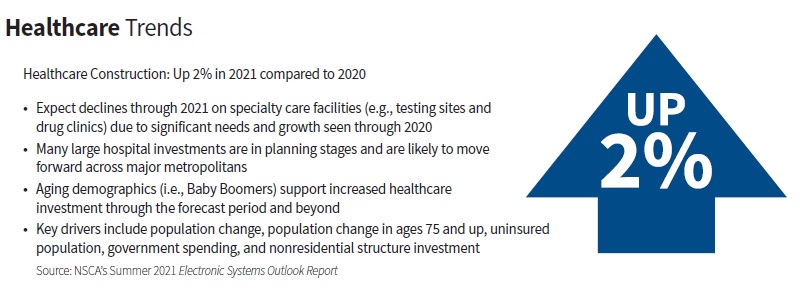“11 Ways the Integration Business Will Change This Decade” is a wide-ranging analysis by NSCA board members of the future of integration, originally published in the special Pivot to Profit+ section of the Q3 2021 edition of our quarterly trade journal, Integrate. This column discusses the evolution of healthcare technology.
Expectations of healthcare customers will evolve exponentially over the next decade. Integrators should prepare for real-time communication, self-service, and more data-oriented solutions.
By Kyle Habben

The last two years have challenged the healthcare industry to rethink how they support their patients, families, staff, and systems. Leaders are looking at new ways to meet the needs of their patients and families inside and outside the room while keeping their organization healthy from people and financial standpoints. Patient care continues to be at the forefront of technology decisions, including future factors such as:
Real-time communication with patients and loved ones
After feeling disconnected during hospital stays, families are reevaluating what their expectation of patient care and satisfaction looks like. They want to communicate with patients and providers whether they’re in the room or 1,000 miles away. Families will look for interactive patient care systems and hospitals that support patient and loved-ones communication, diversity in patients (culture, language, and religion), and medical information (allergies, history, education), no matter the location.
Hands-on or hands-off approach: the patient’s choice
The generation of digital natives is shifting the approach to patient care and bringing in demand for self-service options from home or during a hospital stay. Patients want choices, whether a care provider stands in the room to guide them or they have a way to access pertinent medical information, such as education, recovery steps, medical charts, their stay, and ways they communicate with their care team and visitors.
You Can Still Watch NSCA’s 2021 Pivot to Profit Sessions. Email Deb Gaskill at dgaskill@nsca.org to get started.
IT influence on patient systems and care
With a push for more data, easier-to-use systems, integration options, and maximizing budgets, more seats are being added to the decision-maker table, giving greater influence and decision-making to IT and informatics teams.

NSCA Board Member Kyle Habben
These players will be a deciding factor in determining the technology resources (systems and people) needed to support and manage clinical workflow and data, what systems will integrate (EMR), and what systems are no longer needed.
Patient choices and care options will continue to drive technology purchases for the future. The technologies will be focused on rightsizing to the environment in terms of costs and size, meeting the patients where their needs are, and making the organization a “healthcare facility of choice.”
Ten years from now, no matter the location, the technology departments will give you options for care and access to those you love, those who care for them, and medical information with a device of your choosing.
Kyle Habben is president of Electronic Contracting Company and an NSCA board member.


